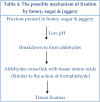Revelation in the field of tissue preservation - a preliminary study on natural formalin substitutes
- PMID: 24155575
- PMCID: PMC3768083
Revelation in the field of tissue preservation - a preliminary study on natural formalin substitutes
Abstract
Introduction: The quest for formalin substitutes has long been going on due to its health hazards. Honey has been proven as a safe alternative to formalin. However, we explored more economical, eco-friendly & readily available substances like sugar & jaggery as natural substitutes for formalin. The aim of this study was to compare the tissue fixation abilities of honey, sugar syrup & jaggery syrup with that of formalin using H & E stain and to determine the best fixative among the three.
Materials and methods: Commercially available fresh goat meat (buccal mucosa) was cut into five bits & each bit was placed in five different containers containing 10% buffered formalin, distilled water, 20% honey, 20% sugar syrup & 30% jaggery syrup with formalin as positive control & distilled water as negative control. 24 hours tissue fixation was attained at room temperature followed by conventional processing and staining. The tissue sections were assessed for cytoplasmic, nuclear details & staining quality under light microscopy. Each criteria was rated on a scale of 1- 4 (1 for poor & 4 for excellent) & the whole procedure was blinded. RESULTS were analysed by Kruskal Wallis ANOVA test. Inter-observer variability was determined by Kappa statistics.
Results: The preservation of tissue by honey, sugar & jaggery syrup was comparable to that of formalin. Among the three natural fixatives, jaggery syrup excelled.
Conclusion: Our effort of using sugar and jaggery for tissue fixation is first of its kind and yielded good results. Hence they can be successfully adopted in routine histopathology laboratories in place of formalin.
Clinical relevance: Natural fixatives can be used in place of the hazardous formalin with equal efficiency. Also, jaggery being highly economical and universally available can be employed in large scale as in screening camps. How to cite this article: Patil S, Premalatha B R, Rao R S, Ganavi B S. Revelation in the Field of Tissue Preservation - A Preliminary Study on Natural Formalin Substitutes. J Int Oral Health 2013; 5(1):31-38.
Keywords: Formalin substitutes; Honey; Natural tissue fixatives; Non- formalin fixatives; Sugar syrup; jaggery syrup.
Conflict of interest statement
Conflict of Interest: None Declared
Figures





Similar articles
-
Comparitive efficacies of a natural fixative with a conventional fixative.J Oral Maxillofac Pathol. 2017 Sep-Dec;21(3):458. doi: 10.4103/jomfp.JOMFP_236_15. J Oral Maxillofac Pathol. 2017. PMID: 29391731 Free PMC article.
-
Probing natural substitute for formalin: Comparing honey, sugar, and jaggery syrup as fixatives.Natl J Maxillofac Surg. 2018 Jan-Jun;9(1):14-21. doi: 10.4103/njms.NJMS_57_17. Natl J Maxillofac Surg. 2018. PMID: 29937654 Free PMC article.
-
Natural sweeteners as fixatives in histopathology: A longitudinal study.J Nat Sci Biol Med. 2015 Jan-Jun;6(1):67-70. doi: 10.4103/0976-9668.149089. J Nat Sci Biol Med. 2015. PMID: 25810637 Free PMC article.
-
Rethinking tissue preservation: A review of non-toxic and environmentally sustainable fixatives.Ann Diagn Pathol. 2025 Oct;78:152500. doi: 10.1016/j.anndiagpath.2025.152500. Epub 2025 May 13. Ann Diagn Pathol. 2025. PMID: 40378504 Review.
-
Natural fixatives alternative to formalin in histopathology: A systematic review.Med J Malaysia. 2023 Jan;78(1):98-108. Med J Malaysia. 2023. PMID: 36715199
Cited by
-
Comparitive efficacies of a natural fixative with a conventional fixative.J Oral Maxillofac Pathol. 2017 Sep-Dec;21(3):458. doi: 10.4103/jomfp.JOMFP_236_15. J Oral Maxillofac Pathol. 2017. PMID: 29391731 Free PMC article.
-
Transit fixatives: an innovative study.J Clin Diagn Res. 2015 Mar;9(3):ZM01-3. doi: 10.7860/JCDR/2015/11083.5615. Epub 2015 Mar 1. J Clin Diagn Res. 2015. PMID: 25954725 Free PMC article.
-
Natural substitutes for formalin: A boon to histopathology!!J Oral Maxillofac Pathol. 2018 Jan-Apr;22(1):143. doi: 10.4103/jomfp.JOMFP_53_16. J Oral Maxillofac Pathol. 2018. PMID: 29731573 Free PMC article.
-
Probing natural substitute for formalin: Comparing honey, sugar, and jaggery syrup as fixatives.Natl J Maxillofac Surg. 2018 Jan-Jun;9(1):14-21. doi: 10.4103/njms.NJMS_57_17. Natl J Maxillofac Surg. 2018. PMID: 29937654 Free PMC article.
-
Natural sweeteners as fixatives in histopathology: A longitudinal study.J Nat Sci Biol Med. 2015 Jan-Jun;6(1):67-70. doi: 10.4103/0976-9668.149089. J Nat Sci Biol Med. 2015. PMID: 25810637 Free PMC article.
References
-
- Cecil H Fox, Frank B Johnson, John Whiting, Peter P Roller. Formaldehyde Fixation. J Histochem Cytochem. 1985;33(8):845–853. - PubMed
-
- Rosai J. Why microscopy will remain a cornerstone of surgical pathology. Lab Invest. 2007;80:403–408. - PubMed
-
- Rene J Buesa. Methods in Pathology Histology without formalin? Annals of Diagnostic Pathology. 2008;12:387–396. - PubMed
-
- Formaldehyde. OSHA
-
- Kok LP, Boon ME. Coulomb Press; Leyden: 2003. Microwaves for the Art of Microscopy; p. 368.
LinkOut - more resources
Full Text Sources
